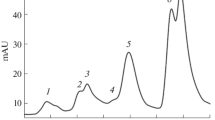Abstract
Phytochrome controls the appearance of many enzymes in the mustard (Sinapis alba L.) cotyledons. The problem has been whether the effect of phytochrome on the appearance of enzymes in this organ is due to a common initial action of Pfr, e.g. due to the liberation of a “second messenger”. We have compared the modulation by light (phytochrome) of the appearance of phenylalanine ammonia lyase (PAL)+ and ribulosebisphosphate carboxylase (Carboxylase)+. PAL becomes detectable in the mustard cotyledons at 27 h after sowing while Carboxylase starts to appear only at 42 h after sowing (starting points, 25° C). The starting points cannot be shifted by light. As a major result, in the case of PAL the inductive effect of continuous red light (given from the time of sowing) remains fully reversible by 756 nm-light up to the starting point (27 h after sowing) while with Carboxylase full reversibility in continuous red light is lost at approximately 15 h after sowing. While the induction of Carboxylase is already saturated at a very low level of Pfr (e.g. continuous 756 nm-light saturates the response) and does not depend on irradiance (e.g. continuous 675 mW m-2 red light and 67.5 mW m-2 red light lead to the same time course), PAL induction is a graded response over a wide range of Pfr doses and depends strongly on the fluence rate (high irradiance response, HIR). It is concluded that PAL induction and Carboxylase induction are not only separated in time but differ in every regard except that both responses are mediated by phytochrome.
The present data support the previous conclusion that the specification of the temporal and spatial pattern of development is independent of phytochrome even though the realization of the pattern of development can only occur in the presence of phytochrome (Pfr). It seems that there is no feedback from pattern realization to pattern specification.
Similar content being viewed by others
Abbreviations
- Pfr :
-
the far-red absorbing, physiologically active form of phytochrome
- Pr :
-
the red absorbing physiologically inactive form of phytochrome
- Ptotal :
-
[Pr]+[Pfr]
- PAL:
-
phenylalanine ammonia-lyase (EC 4.3.1.5)
- Carboxylase:
-
ribulosebisphosphate carboxylase (EC 4.1.1.39)
References
Brüning, K., Drumm, H., Mohr, H.: On the role of phytochrome in controlling enzyme levels in plastids. Biochem. Physiol. Pflanzen 168, 141–156 (1975)
Drumm, H., Mohr, H.: The dose response curve in phytochromemediated anthocynin synthesis in the mustard seedling. Photochem. Photobiol. 20, 151–157 (1974)
Durst, F., Mohr, H.: Phytochrome-mediated induction of enzyme synthesis in mustard seedlings (Sinapis alba L.). Naturwissenschaften 53, 531–532 (1966)
Ellis, R.J.: Inhibition of chloroplast protein synthesis by lincomycin and 2-(4-methyl-2,6-dinitroanilino)-N-methylpropionamide. Phytochemistry 14, 89–93 (1975)
Frosch, S., Bergfeld, R., Mohr, H.: Light control of plastogenesis and ribulose bisphosphate carboxylase levels in mustard seedling cotyledons. Planta 133, 53–56 (1976)
Hartmann, K.M.: A general hypothesis to interpret “high energy phenomena” of photomorphogenesis on the basis of phytochrome. Photochem. Photobiol. 5, 349–366 (1966)
Jabben, M., Mohr, H.: Stimulation of the Shibata shift by phytochrome in the cotyledons of the mustard seedling. Photochem. Photobiol. 22, 55–58 (1975)
Kasemir, H., Huber, P., Mohr, H.: Timing of the initial action of phytochrome with regard to protochlorophyll synthesis in the mustard seedling. Planta (Berl.) 132, 157–160 (1976)
Kinnersley, A.M., Davies, P.J.: Comparison of three phytochrome-mediated processes in the hypocotyl of mustard. Plant Physiol. 58, 777–782 (1976)
Kleinkopf, G.E., Huffaker, R.C., Matheson, H.: Light-induced de novo synthesis of ribulose 1,5-diphosphate carboxylase in greening leaves of barley. Plant Physiol. 46, 416–418 (1970)
Mohr, H.: Untersuchungen zur phytochrominduzierten Photomorphogenese des Senfkeimlings (Sinapis alba L.). Z. Pflanzephysiol. 54, 63–83 (1966)
Mohr, H.: The role of phytochrome in controlling enzyme levels in plants. In: MTP international reviews of science. Biochemistry series one. Biochemistry of cell differentiation, Vol. 9, pp. 37–81. Paul, J., ed. London: Butterworths 1974
Mohr, H.: Zur Zielsetzung der Entwicklungsbiologie. Biologie in unserer Zeit 6, 161–168 (1976)
Mohr, H., Oelze-Karow, H.: Phytochrome action as a threshold phenomenon. In: Light and plant development, pp. 257–284. Smith, H. ed. London-Boston, Butterworths 1976
Mohr, H., Schoser, G.: Eine Interferenzfilter-Monochromatoranlage für photobiologische Zwecke. Planta (Berl.) 53, 1–17 (1959)
Peter, K., Mohr, H.: Control of phenylalanine ammonialyase and ascorbate oxidase in the mustard seedling by light and Hoagland's nutrient solution. Z. Naturforsch. 29c, 222–228 (1974)
Peterson, L.W., Kleinkopf, G.E., Huffaker, R.C.: Evidence for lack of turnover of ribulose 1,5-diphosphate carboxylase in barley leaves. Plant Physiol. 51, 1042–1045 (1973)
Schäfer, E.: A new approach to explain the “high irradiance responses” of photomorphogenesis on the basis of phytochrome. J. Math. Biol. 2, 41–56 (1975)
Schäfer, E., Lassig, T.-U., Schopfer, P.: Photocontrol of phytochrome destruction in grass seedlings. The influence of wavelength and irradiance. Photochem. Photobiol. 22, 193–202 (1975)
Schäfer, E., Schmidt, W., Mohr, H.: Comparative measurements of phytochrome in cotyledons and hypocotyl hook of mustard (Sinapis alba L.). Photochem. Photobiol. 18, 331–334 (1973)
Schopfer, P.: Phytochrome control of enzymes. Ann. Rev. Plant Physiol. 28, 223–252 (1977)
Schopfer, P., Mohr, H.: Phytochrome-mediated induction of phenylalanine ammonialyase in mustard seedlings. Plant Physiol. 49, 8–10 (1972)
Smith, H.: The mechanism of action and the function of phytochrome. In: Light and plant development, pp. 63–65. Proceedings of 22nd Easter School in Agricultural Science, University of Nottingham 1975
Steinitz, B., Drumm, H., Mohr, H.: The appearance of competence for phytochrome-mediated anthocyanin synthesis in the cotyledons of Sinapis alba L. Planta (Berl.) 130, 23–31 (1976)
Tong, W.F., Schopfer, P.: Phytochrome-mediated de novo synthesis of phenylalanine ammonialyase: A new approach using preinduced mustard seedlings. Proc. Nat. Acad. Sci. (Wash.) 73, 4017–4021 (1976)
Weidner, M.: Der DNS-Gehalt von Kotyledonen und Hypokotyl des Senfkeimlings (Sinapis alba L.) bei der phytochromgesteuerten Photomorphogenese. Planta (Berl.) 75, 94–98 (1967)
Author information
Authors and Affiliations
Rights and permissions
About this article
Cite this article
Frosch, S., Drumm, H. & Mohr, H. Regulation of enzyme levels by phytochrome in mustard cotyledons: Multiple mechanisms?. Planta 136, 181–186 (1977). https://doi.org/10.1007/BF00396196
Received:
Accepted:
Issue Date:
DOI: https://doi.org/10.1007/BF00396196




